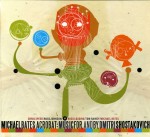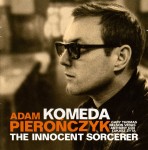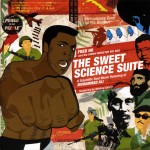Over the past few years as post-modernism has made anything fair game for musical interpretation, sophisticated improviser/composers have taken inspiration from the most unlikely sources, far beyond the motifs, historicism and pastels of earlier times. Canadian bassist in New York Michael Bates for instance, has organized a salute to Dmitri Shostakovich (1906-75), using his own music and variants on the modern Russian composer’s oeuvre. Iconoclastic American composer/saxophonist Fred Ho has produced a five-part suite honouring boxer Muhammad Ali (b.1942) as a militant, outspoken fighter for social justice. The luminous canvases of American visual artist Cy Twombly (1928-2011) stimulate Israeli saxophonist Ariel Shibolet’s creativity, while Polish saxophonist Adam Pierończyk recasts in his own fashion the distinctive film scores of composer Krzysztof Komeda (1931-69).
 Michael Bates’ masterful arrangements on Acrobat: Music For, and By, Dmitri Shostakovich (Sunnyside SSC 1291 www.sunnysiderecords.com) are so perceptive that during the course of nine tracks he almost reveals symphonic colours using only a top-flight quintet: his double bass; the perfectly timed drums of Tom Rainey; Russ Lossing’s shuddering smears from electric and regular pianos; trumpeter Russ Johnson’s brassy blasts; and the fluid lyricism of Chris Speed’s sax and clarinet. This is apparent from the first track, “Dance of Death,” from Shostakovich’s Piano Trio No.2 in E Minor. Very quickly the bouncy melody is transformed with plunger trumpet work and well-modulated reed trills to a motif that’s as much 1970s Miles Davis as it is a mazurka. Later Silent Witness uses fusion references to atmospherically suggest the composer’s Stalin-era paranoia, with Speed’s singular reed slurs becoming progressively lower-pitched and tonal as Rainey`s drums smack and rebound while Lossing’s ratcheting licks make it seem as if he’s playing electric guitar not piano. Held together by Bates’ reliable thumping, the cacophonous final section gives way to repeated theme variations and conclusive keyboard echoes. Elsewhere, with music derived from the Russian composer’s work or not, the tunes use varied strategies. Intermezzos can be atmospheric and formal, with the reedist approximating oboe-like burrs and timed runs arising from Lossing’s acoustic instrument; as loose and swinging as a Benny Goodman-led combo; or exploding with tougher near-Jazz Messengers-like harmonies. Arcangela is another highpoint, allowing both Russes sufficient solo space. The pianist showcases a series of repeated glissandi centred by Bates’ stentorian pulse; while the trumpeter’s capillary slurs evolve into a quicksilver flow cushioned by harmonized keyboard and reed textures. All in all the wrap-around themes simultaneously celebrate Shostakovich’s intent while exposing improvisations that are true to jazz’s ethos.
Michael Bates’ masterful arrangements on Acrobat: Music For, and By, Dmitri Shostakovich (Sunnyside SSC 1291 www.sunnysiderecords.com) are so perceptive that during the course of nine tracks he almost reveals symphonic colours using only a top-flight quintet: his double bass; the perfectly timed drums of Tom Rainey; Russ Lossing’s shuddering smears from electric and regular pianos; trumpeter Russ Johnson’s brassy blasts; and the fluid lyricism of Chris Speed’s sax and clarinet. This is apparent from the first track, “Dance of Death,” from Shostakovich’s Piano Trio No.2 in E Minor. Very quickly the bouncy melody is transformed with plunger trumpet work and well-modulated reed trills to a motif that’s as much 1970s Miles Davis as it is a mazurka. Later Silent Witness uses fusion references to atmospherically suggest the composer’s Stalin-era paranoia, with Speed’s singular reed slurs becoming progressively lower-pitched and tonal as Rainey`s drums smack and rebound while Lossing’s ratcheting licks make it seem as if he’s playing electric guitar not piano. Held together by Bates’ reliable thumping, the cacophonous final section gives way to repeated theme variations and conclusive keyboard echoes. Elsewhere, with music derived from the Russian composer’s work or not, the tunes use varied strategies. Intermezzos can be atmospheric and formal, with the reedist approximating oboe-like burrs and timed runs arising from Lossing’s acoustic instrument; as loose and swinging as a Benny Goodman-led combo; or exploding with tougher near-Jazz Messengers-like harmonies. Arcangela is another highpoint, allowing both Russes sufficient solo space. The pianist showcases a series of repeated glissandi centred by Bates’ stentorian pulse; while the trumpeter’s capillary slurs evolve into a quicksilver flow cushioned by harmonized keyboard and reed textures. All in all the wrap-around themes simultaneously celebrate Shostakovich’s intent while exposing improvisations that are true to jazz’s ethos.
 Transforming the sounds of another musician, whose short-lived but prolific career defined Polish jazz, popular and even notated sounds for years after his untimely death, is the task of Krakow-based tenor and soprano saxophonist Adam Pierończyk on Komeda-The Innocent Sorcerer (JazzWerkstatt JW 104 www.jazzwerstatt.eu). Luckily he has the help of Brazilian guitarist Nelson Veras, countryman Łukasz Żyta on percussion, including typewriter (!) plus two American veterans, bassist Anthony Cox and tenor saxophonist Gary Thomas. Actually it’s Veras who often sets the pace, since his delicate nylon-string strumming brings a bossa nova-like lilt to, and encourages equivalent horn harmonies on, later-period Komeda tunes like After the Catastrophe. Two of Komeda’s best-known themes are treated most substantially by the quintet: Sleep Safe and Warm used in Rosemary’s Baby and Crazy Girl from Knife in the Water. Typewriter sounds produced by Żyta underlie contrasting rubato split tones from Thomas’ tenor and Pierończyk’s soprano sax obbligato during variants on the first tune. Meanwhile sul ponticello bass work makes the theme more menacing, with the piece reaching a crescendo of sharp guitar licks and overlapping horn parts, drastically truncated as the sound of a typewriter’s carriage return completes the track. Bustling cool jazz-like harmonies give way to contrapuntal horn vamping, rapid twangs from the guitarist and broken-metre drumming on Crazy Girl. With the percussionist waving Latin percussion and Cox sliding up and down his strings, Thomas’ hard-toned blowing and Pierończyk’s parallel tongue fluttering define the song’s repeated motif, as the two reedists circle back to recap and draw out the initial head.
Transforming the sounds of another musician, whose short-lived but prolific career defined Polish jazz, popular and even notated sounds for years after his untimely death, is the task of Krakow-based tenor and soprano saxophonist Adam Pierończyk on Komeda-The Innocent Sorcerer (JazzWerkstatt JW 104 www.jazzwerstatt.eu). Luckily he has the help of Brazilian guitarist Nelson Veras, countryman Łukasz Żyta on percussion, including typewriter (!) plus two American veterans, bassist Anthony Cox and tenor saxophonist Gary Thomas. Actually it’s Veras who often sets the pace, since his delicate nylon-string strumming brings a bossa nova-like lilt to, and encourages equivalent horn harmonies on, later-period Komeda tunes like After the Catastrophe. Two of Komeda’s best-known themes are treated most substantially by the quintet: Sleep Safe and Warm used in Rosemary’s Baby and Crazy Girl from Knife in the Water. Typewriter sounds produced by Żyta underlie contrasting rubato split tones from Thomas’ tenor and Pierończyk’s soprano sax obbligato during variants on the first tune. Meanwhile sul ponticello bass work makes the theme more menacing, with the piece reaching a crescendo of sharp guitar licks and overlapping horn parts, drastically truncated as the sound of a typewriter’s carriage return completes the track. Bustling cool jazz-like harmonies give way to contrapuntal horn vamping, rapid twangs from the guitarist and broken-metre drumming on Crazy Girl. With the percussionist waving Latin percussion and Cox sliding up and down his strings, Thomas’ hard-toned blowing and Pierończyk’s parallel tongue fluttering define the song’s repeated motif, as the two reedists circle back to recap and draw out the initial head.
 Moving on from celebrating masterful musicians’ compositional influences to appreciating the political subtext of someone dubbed “Athlete of the Century,” is The Sweet Science Suite (Mutable/Big Red Media 003 www.bigredmediainc.com), a five-part suite Fred Ho composed for his 19-piece Green Monster Big Band. An activist as well as a musician, Ho’s arrangements are as outstanding and unique as Muhammad Ali’s boxing style. Unafraid of outside references, on Shake up the World the piece’s staccato exposition quotes liberally from Cream’s Sunshine of Your Love for a proper period feel, although that theme is intertwined with vamping section work echoing the Count Basie band, a funky backbeat, fiery brass triplets and a slinky boppish tenor sax solo. Other variants, such as Rope-A-Dope frame Salim Washington’s muscular big-toned tenor saxophone in a lusty big band arrangement that’s part ballad and part free form. Still other tunes expose and bury references to interludes ranging from Chinese court music to American TV show themes, to speeding train-like riffs plus Charles Mingus’ particular blend of gospel and blues. Other examples of bravura (over)blowing include Ho’s double-tonguing a staccatissimo baritone sax interlude from pedal point to altissimo range that is outlined clearly among brass fanfares and gruff snorts from two bass trombones plus broken beats from percussionist Royal Hartigan. The climactic key to the suite is the constantly expanding No Vietnamese Ever Called Me a Nigger, where Hartigan’s stylized gongs and hammered cross tones suggest the sounds of the Vietnam War that Ali avoided, costing him his championship status. Throughout the more-than-16-minute narrative, sonic interpolations, encompassing split-second theme inferences, bluesy harmonies from the six-piece sax section, twanging guitar riffs, discordant trumpet blasts, pedal-point bass trombone snorts and a final, unexpected, smoothing coda describe the discordance of the era and its final resolution. This resolution, personified by abrasive guitar solos and split-tone reed explosions, leads to Worthy of Praises Most High, a concluding theme that acknowledges Ali’s undiminished skill. Triumphantly fortissimo and atonal, the finale highlights guitarist Amanda Monaco’s rock-like chording arching over sequences of juddering pitch dislocation from brass triplets until decisive orchestral calmness prevails.
Moving on from celebrating masterful musicians’ compositional influences to appreciating the political subtext of someone dubbed “Athlete of the Century,” is The Sweet Science Suite (Mutable/Big Red Media 003 www.bigredmediainc.com), a five-part suite Fred Ho composed for his 19-piece Green Monster Big Band. An activist as well as a musician, Ho’s arrangements are as outstanding and unique as Muhammad Ali’s boxing style. Unafraid of outside references, on Shake up the World the piece’s staccato exposition quotes liberally from Cream’s Sunshine of Your Love for a proper period feel, although that theme is intertwined with vamping section work echoing the Count Basie band, a funky backbeat, fiery brass triplets and a slinky boppish tenor sax solo. Other variants, such as Rope-A-Dope frame Salim Washington’s muscular big-toned tenor saxophone in a lusty big band arrangement that’s part ballad and part free form. Still other tunes expose and bury references to interludes ranging from Chinese court music to American TV show themes, to speeding train-like riffs plus Charles Mingus’ particular blend of gospel and blues. Other examples of bravura (over)blowing include Ho’s double-tonguing a staccatissimo baritone sax interlude from pedal point to altissimo range that is outlined clearly among brass fanfares and gruff snorts from two bass trombones plus broken beats from percussionist Royal Hartigan. The climactic key to the suite is the constantly expanding No Vietnamese Ever Called Me a Nigger, where Hartigan’s stylized gongs and hammered cross tones suggest the sounds of the Vietnam War that Ali avoided, costing him his championship status. Throughout the more-than-16-minute narrative, sonic interpolations, encompassing split-second theme inferences, bluesy harmonies from the six-piece sax section, twanging guitar riffs, discordant trumpet blasts, pedal-point bass trombone snorts and a final, unexpected, smoothing coda describe the discordance of the era and its final resolution. This resolution, personified by abrasive guitar solos and split-tone reed explosions, leads to Worthy of Praises Most High, a concluding theme that acknowledges Ali’s undiminished skill. Triumphantly fortissimo and atonal, the finale highlights guitarist Amanda Monaco’s rock-like chording arching over sequences of juddering pitch dislocation from brass triplets until decisive orchestral calmness prevails.
 In contrast to the other CDs’ inspirations, Ariel Shibolet’s Scenes from an Ideal Marriage (Kadima Collective KCR 28 www.kadimacollective.com) expresses in music his interpretation of Cy Twombly’s acrylic and pencil painting of the same name. Part of a trilogy of CDs by the tenor saxophonist dedicated to the recently deceased visual artist, Scenes also features violist Nori Jacoby. Despite obvious differences, like partners in an ideal marriage, the timbres from Shibolet’s soprano saxophone and Jacoby’s viola are sometimes indistinguishable, especially when involved in intertwined dialogue. At times polyphonic, polytonal or polyharmonic, the instruments’ textures mix without blending or losing individual identities. Masterful in his use of multiphonics, the reedist lip burbles, pushes unaccented air through his horn’s body tube, hums through his mouthpiece while sounding a tone, and squawks wet glissandi. Meantime the fiddler’s strategy involves sul ponticello scrapes, flying spiccato scrubs and jagged, angled vibrations. By the time the climactic second theme variant is heard, Shibolet’s pinched ney-like whistles and Jacoby’s sul tasto strokes surmount abrasive atonalism. The defining intermezzo is unexpectedly lyrical in contrast to the exposition, but doesn’t neglect pressure for prettiness. When each player’s timbres become as thin as pencil strokes, the subsequent split tones (from the saxist) and angled strokes (from the violist) stretch the sound without breaking it and eventually combine for wide-bore smears which advance then conclude the recitation.
In contrast to the other CDs’ inspirations, Ariel Shibolet’s Scenes from an Ideal Marriage (Kadima Collective KCR 28 www.kadimacollective.com) expresses in music his interpretation of Cy Twombly’s acrylic and pencil painting of the same name. Part of a trilogy of CDs by the tenor saxophonist dedicated to the recently deceased visual artist, Scenes also features violist Nori Jacoby. Despite obvious differences, like partners in an ideal marriage, the timbres from Shibolet’s soprano saxophone and Jacoby’s viola are sometimes indistinguishable, especially when involved in intertwined dialogue. At times polyphonic, polytonal or polyharmonic, the instruments’ textures mix without blending or losing individual identities. Masterful in his use of multiphonics, the reedist lip burbles, pushes unaccented air through his horn’s body tube, hums through his mouthpiece while sounding a tone, and squawks wet glissandi. Meantime the fiddler’s strategy involves sul ponticello scrapes, flying spiccato scrubs and jagged, angled vibrations. By the time the climactic second theme variant is heard, Shibolet’s pinched ney-like whistles and Jacoby’s sul tasto strokes surmount abrasive atonalism. The defining intermezzo is unexpectedly lyrical in contrast to the exposition, but doesn’t neglect pressure for prettiness. When each player’s timbres become as thin as pencil strokes, the subsequent split tones (from the saxist) and angled strokes (from the violist) stretch the sound without breaking it and eventually combine for wide-bore smears which advance then conclude the recitation.
Sonic inspiration can come from anywhere. It’s up to the canny improviser to do the best he or she can with it, as these musicians demonstrate.



